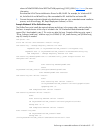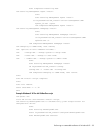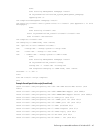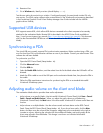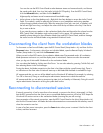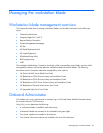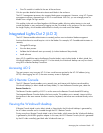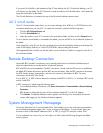User information 44
Using a local directory file
Setting up the Enterprise Directory may not be practical for smaller installations. Instead, it may be more
efficient to use a directory file that resides on the client. The directory file contains a list of systems
assigned to authorized users on that client. For details on the content of the directory file, see the HP
Remote Graphics User's Guide.
(Default) You will be asked for your username and password twice for each blade-once from RGS to
authenticate the connection, and once by Windows® for login authentication. Enter your user name and
password in the indicated boxes and click OK. In many environments, you must provide a Windows
domain for RGS connection authentication. In this case, enter domain\username in the User name box.
For example, a user named "mhsmith" in the "Americas" domain will enter Americas\mhsmith in the User
name box. If you are unsure whether domain authentication is used at your site, contact your
administrator.
(Variation) If the administrator has enabled RGS Easy Login, you'll see only the standard Windows login
screen for each assigned blade. Log into Windows as you normally would.
If your organization has implemented Single Sign-on with RGS, the only authentication prompt (username
and password) displayed is from the RGS Receiver on the client, and it is displayed only once. After
authentication by the RGS Receiver, the blade Windows desktop is displayed, logged-in and ready to
use.
Using manual entry
If the Enterprise Directory or the local directory file is not used at your site, you will need to manually enter
the name or IP address of your assigned blade. A local administrator can provide this information. Only a
single blade can be accessed from each client using manual entry.
(Default) From the RGS control panel, enter the name or IP address of your assigned blade in the
Hostname box. Depending on how your local network is configured, the system name could be short (for
example, "willard") or long (for example, "willard.fc.hp.com"), or you might need to enter the IP address
of your assigned blade (for example, 10.10.24.145). Enter the name or address of the blade in the box
and click Connect. If the system is operational, you will see a connection authentication window with
"Authenticate to <system name>" in the title bar.
Enter your user name and password in the indicated boxes, and click OK. In many environments, you
must provide a Windows domain for authentication. In this case, enter domain\username in the User
name box. For example, a user named "mhsmith" in the "Americas" domain will enter Americas\mhsmith
in the User name box. If you are unsure whether domain authentication is used at your site, contact your
administrator.
After entering your login information, the Windows login screen (generated from the blade) appears on
the client display. You can interact with the Windows screen in much the same way as a traditional PC or
workstation.
(Variation) If the administrator has enabled Easy Login on the blade, there will be no RGS connection
authentication window. The Windows login or lock screen appears on the client. In this case, just log into
Windows as you normally would.
(Variation) If your organization has implemented Single Sign-on, the only authentication prompt
(username and password) displayed is from the RGS Receiver on the client. After authentication by the
RGS Receiver, the blade Windows desktop of the blade is displayed, logged-in and ready to use.




